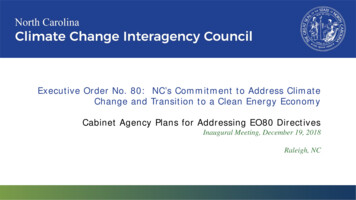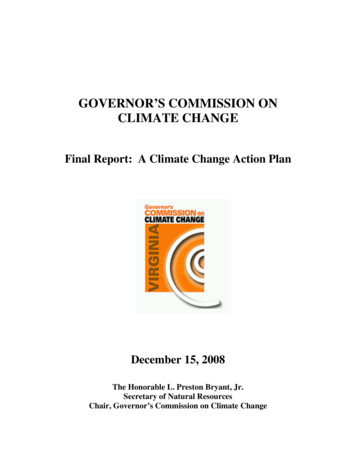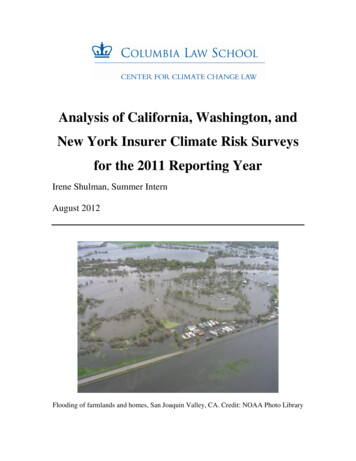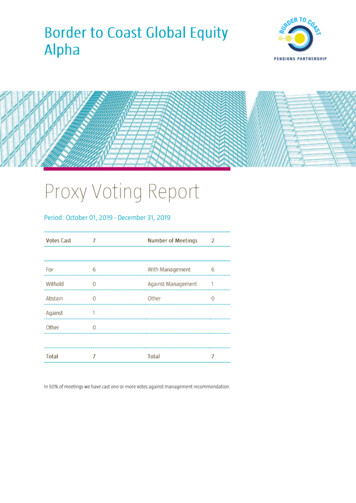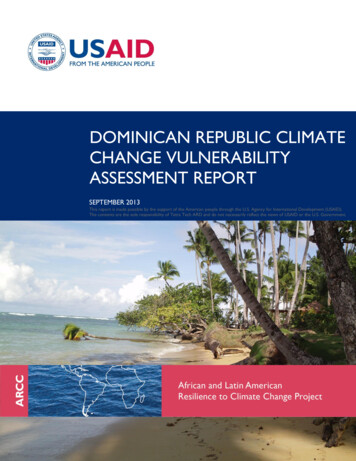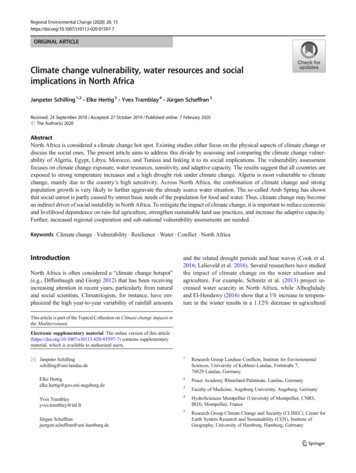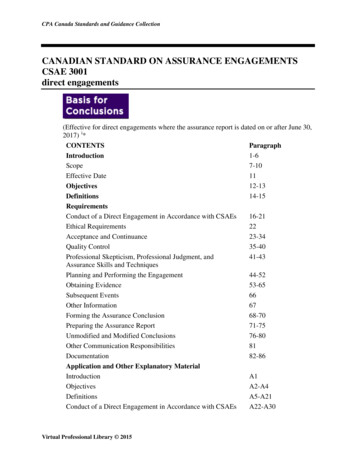
Transcription
DRAFTA Comprehensive Climate Change Engagement and EducationCampaign at Cornell UniversityExecutive SummaryCornell University has the opportunity to bring about a change in culture across the entirecampus by insuring that every student, faculty, and staff member understands thechallenges posed by climate change and actively engages in solutions. We are proposing tobuild on Cornell’s successes to date in reducing greenhouse gas emissions by launching aclimate change literacy campaign that will include enhancements of the curriculum,student orientation programs, and professional development and leadership programs forstaff and faculty. With an inspired, motivated and empowered community, we propose toimplement Think BIG, Live Green in every college, school and department resulting inreductions in energy use that in aggregate will save at least 650,000/yr. in electricity costsalone. The rate of return on investment is exceptionally high and self-sustaining. What isparticularly unique about this engagement and education campaign is the involvement ofCornell’s faculty who are eager to contribute their expertise to improve climate changeliteracy and change human behaviors around energy use, the core components of thiscampaign. The challenge we face with a rapidly warming climate is great but so is Cornell’scapacity to meet ng on progress to date: Cornell University is already seen as a leader in reducing itsgreenhouse gas emissions through efforts such as Lake Source Cooling, the Combined Heatand Power plant, solar PV installations, and the continuing efforts to drastically improveenergy efficiency through facility upgrades and retrofits. Since 2000 the Cornell buildingfootprint has grown by 20%, yet campus-wide energy use has not increased. In addition,pilot programs such as CALS Green have demonstrated what is possible through relativelysimple changes in behavior in the buildings we occupy. CALS Green resulted in anestimated savings of 230,000 in six buildings and GHG reductions 2 million lbs. over 12months (Frongillo et al. 2012). However, what was unique about CALS Green was thepartnership with faculty and their graduate students who through their research addedgreatly to the value of the CALS Green pilot project. Instead of a simple demonstrationproject it was also a study of human behavior (Dixon et al. 2015, 2015a). One importantaspect of CALS Green was a 2009 benchmark survey of the CALS community indicating that84% of the 2,296 respondents thought it was their personal responsibility to help Cornellsave energy (McComas et al. 2012). A subsequent survey in 2012 (n 2,919 respondents inCALS, Johnson, CoE) showed respondents were generally concerned about climate changeand reported believing both they and Cornell could do something about it (McComas et al.2012).The university-wide successor to CALS Green—the Think BIG, Live Green campaign—employs multiple complementary initiatives to educate users with real-time energy useand cost data (e.g., building dashboards), as well as best practices customized to the work1
DRAFTplace, whether it be a classroom, office, lab, residence hall, kitchen, etc. “GreenAmbassadors” provide education, leadership development, social marketing, resources,and oversight of these initiatives. One Energy Smack-Down demonstration of Thing BIG,Live Green Campaign encompassing six Cornell buildings demonstrated a savings ofapproximately 9,000 over 6 weeks. When fully implemented, the Think BIG, Live Greencampaign aims to reduce the electricity consumption use by at least 1% each year,equivalent to 7.2MWh and saving at least 650,000 per year. Although Think BIG, LiveGreen focuses on reducing usage of electricity, there are also opportunities to reduce heatand cooling costs through behavioral change (e.g., keeping building doors and windowsclosed).The CALS Green initiative and the Think BIG, Live Green campaign resulted in considerablesavings but there are also other ways to reduce energy use and costs such as through Leanprocess improvement projects. One particular Lean project resulted in a reduction ofgreenhouse footprint by 25,000 sq. ft. and an annual savings of 160,000- 212,000 inheating and 40,000- 70,000 in electricity costs and 120,000 in annual preventivemaintenance costs. The return on investment in these various initiatives is exceptionallyhigh. These efforts also demonstrate the positive improvements resulting from changes inhuman behavior and the importance of engaging and empowering the Cornell community.In total, Cornell has conducted 84 Lean projects as of June 2016, yielding millions in bothone-time and on-going cost savings for the university.ApproachIncreasing climate change literacy: To bring about the necessary sea-change in attitude andbehavior the Cornell community must truly appreciate the gravity of the challenge we facewith our rapidly warming climate. Our own researchers (Allred, et. al. unpublished) haveshown that once people accept that climate change is human-caused they are more likely toact to address it. We also believe there is an inherent moral responsibility to share theclimate change facts with all members of the Cornell community, particularly to ourstudents who will feel the brunt of the changes in coming years. They need to be educatedin this area so that they can make informed career choices and become effective globalcitizens in their ensuing professional and personal lives. They would also carry with them adeeper respect and appreciation for what the Cornell experience has meant to their livessince “we told them” while they were here at Cornell. The climate literacy campaign wouldneed to encompass every level of leadership at Cornell including the Trustees, as well asstaff, faculty and alumni. A proposed definition of climate literacy and learning outcomes(based on NOAA) follows: Climate Change Literacy is an understanding of your influence on climate andclimate’s influence on you and society. A climate-literate persono understands the essential principles of Earth’s climate system,o understands the anthropogenic nature of climate change,o understands the likely impacts of climate change on humans andecosystems,o knows how to assess scientifically credible information about climate,2
DRAFTo understands how to communicate about climate and climate change in ameaningful way, ando is able to make informed and responsible decisions with regard to actionsthat may affect climate.What follows are some of the more important actions that will help us achieve a climateliterate community at Cornell.Students:An ACSF Future topical lunch - Achieving climate change and sustainability literacy atCornell - was convened in April, which brought together 20 faculty and staff to assess thecurrent status of climate change literacy for our students. Subsequently, a group of facultyconvened and is now in the process of systematically assessing what is available tostudents and plan to have that information summarized by August 2016. Examples include: The climate change minor encompasses many of the climate change coursescurrently available but the number of students enrolled in the minor is small 25. The minor should be better marketed to all students. There are additional courses, which contain some climate change componentsbut there should be a more coordinated approach to how all climate changecurricular activities are offered. Adopting the new University of California workshop approach in which facultyconsider ways in which climate change can be inserted into their courses. There are additional educational opportunities for students such as duringfreshman orientation and writing seminars, The new campus-wide climate change seminar series offered each spring ispopular (120 registered students in 2016) but should be marketed widely. Students should also be encouraged to engage in the many sustainability clubsthat provide opportunities for applied learning, now coordinated by ECO. There are innumerable ways to inculcate climate change education (classroomand experiential) into an undergraduate and graduate student’s life at Cornell,but this requires a more coordinated approach.Staff and faculty:Cornell’s Staff Skills for Success overriding principle, which is used for annual performancedialogues, sets the stage very well for staff and faculty to gain knowledge about climatechange and how they can be part of the solution. The principle reads:Success is neither fleeting nor accidental. Choices we make today impact our future andall who succeed us. Sustainability is meeting the needs of the present without compromisingthe ability of future generations to meet their own needs. A culture of sustainability seesopportunities in every Skill for Success to be more sustainable. Individually, we make adifference; collectively, we change our communities, Cornell and the world.Examples of specific actions to improve climate literacy for staff and faculty include: Encouraging staff and faculty to attend the new climate change seminar series3
DRAFT Adding a staff climate change/sustainability program to the professionaldevelopment programming including orientation of new employees.Encouraging more managers to attend the sustainability program offered throughCornell’s Management Academy, and continue to build upon the sustainabilityreferences integrated into Cornell’s leadership curriculum,Continuing promotion of the Green Office Certification, Green Labs certificateprogram and educate and engage offices in identifying ways to behave moresustainably as a workgroup,Including metrics for addressing climate change in the workplace in performancedialogues and individual development plans – making it part of the culture.Creating/sharing educational video’s, podcasts, TEDx talks, sustainabilitygamification, etc., in some cases already developed by faculty, andInnumerable other opportunities to share the climate change story and solutions atregular or annual gatherings of staff and faculty such as the Faculty Senate andEmployee Assembly as well as at unit gatherings.Implementing Think BIG, Live Green in all departments, schools and colleges: We fully realizethat behavioral changes will be incremental and relatively small on an individual basiscompared to major changes such as improvements in infrastructure but by changing themindset – an adoption of a culture of sustainability - at an organization the size of Cornellwith its nearly 22,000 students, 1,600 faculty, 1,100 academic professionals, and 7,000 staffwe believe the aggregate benefit will be significant. We also see an opportunity for ourcommunity to carry this message to their homes, places of faith, civic groups, and otherorganizations in which they are involved to bring about change well beyond the boundariesof Cornell.Cornell’s greenhouse gas reduction targets will not be achieved without promoting bothimmediate and sustained changes in behaviors related to energy conservation. Indeed,other than changes in the physical plant and energy sources for the university, all otheroptions involve behavior change at the individual level, from turning off lights to changingcommuting patterns. Given the urgency of climate change challenge, key behaviors mustchange in a short time; equally important, they must stay changed to have maximumimpact.Cornell is fortunate in having extensive resources in those areas needed to maximize thebenefits of behavior change initiatives. A number of faculty are devoting their scientificcareers to issues of decision-making, behavior change, behavioral economics, and theimplementation and evaluation of evidence-based programs. We propose that Cornell tapthese research resources to set the agenda for its environmental behavior changeinitiatives and to monitor their effectiveness. Indeed, this is another example of Cornellbeing a true “living laboratory” for the development and dissemination of effectivebehavior change initiatives that promote a multitude of ways to reduce energy use.The systematic application of behavior change science is the best option to promoteenergy conservation. This application can in turn lead to translational research initiatives4
DRAFTthat develop and test programs and practices designed to help students, faculty, and staffinitiate and maintain behavior change. Some of these initiatives can employ Cornellresearch on the use of emerging technologies that involve interpersonal communicationand real time social information analysis.A reservoir of relevant research on the science of behavior change is available fortranslation to interventions promoting environmental sustainability. The following are fourexamples: Cornell faculty study how people psychologically represent time and make decisionsover time. A major difficulty with environmental behavior change is the humantendency to devalue distant gains and losses relative to more immediate ones.Evidence-based avenues for interventions exist in this area that can be used topromote environmental behavior. Social scientists at Cornell are developing methods to optimize the way informationis conveyed to help change behavior. Studies suggest that people are very sensitiveto the specific wording that is used to present a given piece of information.Therefore, interventions using individualized message framing to promote behaviorchange can be applied to help attain Cornell’s sustainability goals. Cornell can be a leader in leveraging technology to effect behavior change aroundsustainability. Faculty is working on issues of behavior change in the contexts of theuse of online information and of technology such as smartphones or potentially acarbon footprint Fitbit. Cornell has leading scientists in the area of risk and rational decision-making,ranging from economists to neuroscientists. Many of their models and methods canbe applied to achieve sustainability goals.In sum, we believe that tapping the extensive scholarly resources available at Cornellconstitute a critical path to promoting environmental behavior change at the university. Wepropose to build on existing programming and successes to (1) determine the bestmethods of promoting sustainable behavior; (2) systematically implement programs mostlikely to work; and (3) use faculty expertise to evaluate and refine these programs asneeded.Organizational structure/leadership: To maximize the benefits of Cornell research andeducational resources related to climate change and achieving climate neutrality, wepropose the establishment of two working groups.1. Climate Change Literacy Working Group. The group would provide the intellectualunderpinning for the campus-wide climate literacy initiative and would report to the PSCCExecutive Committee. Members would include:Jeff Tester (CoE), Natalie Mahowald, Bruce Monger (CALS), Joe Burke, MikeHoffmann (CALS), Sarah Brylinsky (Office of Sustainability), Mark Milstein(Johnson), Student representative.5
DRAFT2. Behavior Change Working Group who would also report to the PSCC ExecutiveCommittee. This group would build on successes to date such as CALS Green and Think BIG,Live Green and enhance as needed. They would be charged to identify evidence-basedprograms that have the greatest degree of success. Equally important, they would helpprevent the use of programs that do not work, or may even have unintended negativeeffects. A subset of the following individuals would form the working group.Jon Schuldt,* Communication, climate change messaging and public opinionAdam Levine, Government, citizen participation in climate change actionRich Stedman,* Natural Resources, human dimensionsDavid Filiberto,* Industrial Labor RelationsKarl Pillemer,* College of Human Ecology, Bronfenbrenner Center forTranslation Researcho Brian Wansink, Dyson Schoolo Linda Croll Howell,* Human Resource Analyticso Kathy Burkgren, Organization and Workforce Developmento Mike Hoffmann,* Cornell Institute for Climate Change and Agricultureo Sustainability Engagement Manager from the Campus Sustainability Officeo Resource contacts: Sue Fussell, Communication (instrumental in CALS Green interactivewebsite) Marianne Krasny, short educational videos, civic engagement PSCC Focus Teams Katherine McComas, Dept. of Communications, risk communication Drew Margolin,* Communication, social media, Fitbit development, a testbed for social media to change a culture of an organization. Cornell Team and Leadership Center, Cornell Management Academy Cornell office for Research on Evaluation (CORE)*Contacted and interested in participatingooooo Funding – grants program: Although we believe there would be considerable interest inthis overall initiative, funding for a small grants program for applied research andeducational programming by faculty on environmental behavior change would beimportant. Cornell must provide incentives for faculty to become involved in findingsolutions, as the experimental data obtained from these funded projects will also relateto their research interests. Faculty from a wide range of disciplines can develop and testinterventions that can then be expanded to benefit the entire university. Teammembers would seek additional funding from federal, state and foundation grantsources to add value to the base resource provided by Cornell. Such a proposedinitiative would also lend itself to crowdfunding and support from alumni.o Budget: 50,000/yr. Funding – staff and technical support:o Create a full-time staff position focused on ensuring a climate literate communityat Cornell. This would include coordination of the overall effort, administrationof the grants program, and supporting the working groups. The position would6
DRAFTbe housed in the Sustainability Office but work closely with climate literacyworking group. Budget: 75,000/yr.o Sustain the Think BIG, Live Green campaign staffing in the Office ofSustainability. Would work closely with behavior working group.o Support will be required to enhance the current Think BIG, Live green websiteincluding an on-line interactive system that will insure engagement ofparticipants and foster a competitive spirit that was key to the success of CALSGreen. Budget: 20,000/yr.o The overall initiative must document the return on investment from thesepositions in the long term. We are confident that the return in energy savingsalone will be multifold their combined salaries and self-sustaining in the longterm.References:Frongillo, D., L. Chambliss, A. Timm, G. Liu, A. O’Neil, and D. Sexton. 2012. CALS Green:Energy conservation and sustainability initiative, report and recommendation. Internalreport. 73 pp.Dixon, G., M. B. Deline, K. McComas, L. Chambliss, & M. Hoffmann. 2015. Saving Energy atthe Workplace: The Salience of Behavioral Antecedents and Sense of Community.Energy Research and Social Science 6: 121-127.Dixon, G., M. Deline, K. McComas, L. Chambliss & M. P. Hoffmann. 2015a. Using comparativefeedback to influence workplace energy conservation: A case study of a universitycampaign. Environment and Behavior. 47: 667-693.McComas, K., G. Dixon and M. B. Deline. 2012. Opinions about energy conservation atCornell: A 2012 Survey of faculty, staff, and graduate students in Cornell’s College ofAgriculture and Life Sciences, the Samuel Curtis Johnson Graduate School ofManagement, and College of Engineering. Internal report. 46 pp.7
A Comprehensive Climate Change Engagement and Education Campaign at Cornell University Executive Summary Cornell University has the opportunity to bring about a change in culture across the entire campus by insuring that every student, faculty, and staff member understands the challenges posed by climate change and actively engages in solutions.

